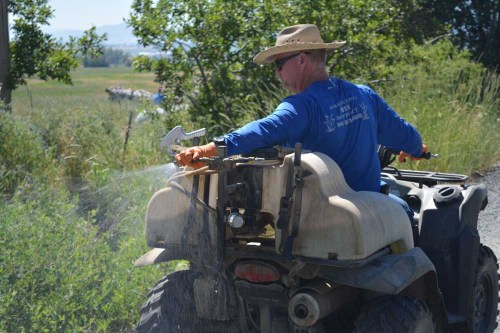Baker County weed control program makes containment of new weed a priority
Published 6:15 am Saturday, July 30, 2022

- Pettingill’s spraying system — which is attached to the back of an ATV — allows him to spray weeds on uneven terrain.
Jeffrey Pettingill is fortunate that the rural roads west of Haines don’t harbor much traffic. His eyes wander often.
He’s searching for signs of an enemy.
Trending
An enemy that, when faced in a one-on-one battle with Pettingill’s burly 6-foot-2 frame, doesn’t stand much of a chance. He can win by simply gripping the base of its green-gray stem, pulling and exposing its annual root, which is only a few inches long.
But Pettingill is outnumbered — this battle will require a more strategic approach.
Chemical warfare, perhaps.
Pettingill, Baker County’s weed control supervisor, is facing Baker County’s newest noxious weed, hoary alyssum, which he hopes to control before it poses a greater threat to livestock, crop production, and native plants.
The first step for Pettingill is identifying where exactly the hoary alyssum — which travels mostly by hitching rides on equipment and the hooves of livestock — has spread.
That’s what he set out to do on Tuesday, July 26, when he traveled to a property in the foothills of the Elkhorns to see how much of the plant was there.
Trending
When Pettingill first saw the weed in the pastures near North Rock Creek Road west of Haines in the summer of 2020, he wasn’t certain he was dealing with hoary alyssum. Its spindly stem and small white flower can be tough to pick out — even with Pettingill’s trained gaze — from clusters of yarrow, a native plant with a similar white flower that grows in similar areas to the hoary alyssum, like fields, rangelands and pastures.
Pettingill applied for a state grant through the Oregon Watershed Enhancement Board (OWEB) to help identify where the weed had spread. He was awarded $9,500 in July of 2021, paid for by Oregon lottery dollars, which supported on-foot surveys that confirmed hoary alyssum’s spread in Baker County.
He also sent a letter to 82 landowners informing them about the new weed.
Although 2020 was the first sighting, Pettingill said he didn’t know when the weed actually arrived in the county and how long it went unnoticed — its modest appearance might have allowed it to spend years growing and spreading under the radar in Baker County.
According to the state’s noxious weed profile, hoary alyssum was already widespread in the Northeastern United States by the 1890s after it was originally transported to North America from Europe as a seed contaminant. It’s listed as a noxious weed in several other Western states.
But hoary alyssum isn’t widespread in Oregon. Other than the recent Baker County infestation, two isolated patches of the plant exist: one in Wallowa County near the town of Wallowa and a dense infestation near Sisters in Deschutes County.
Pettingill said he doesn’t know exactly how the weed spread into Baker County, and that he initially underestimated its local prevalence.
“We didn’t know how vast it was,” Pettingill said.
He discovered that the weed wasn’t only in pastures near Haines, but also in higher elevations in the foothills of the Elkhorn Mountains. Pettengill said he wasn’t aware last summer that the weed had also spread to the pastures near South Rock Creek Road.
He said he believes the weed started in the hills and then moved into the pastures.
Pettingill applied for another state grant of the same amount to continue fighting the weed in 2021 and 2022. Over a third of the grant went to buying herbicides, enough to treat 300 acres of hoary alyssum.
He said he’s already sprayed that amount this year.
He said the amount of the grant is “unfortunate, based on how many acres we found. We need to try to write another one this winter to supplement somehow.”
Since the state has classified hoary alyssum as “noxious,” property owners who find it on their land are required to take some kind of action — either themselves or through Pettingill’s program — to control it.
Landowners can also participate in a cost share program, separate from the hoary alyssum grants, where the county will reimburse owners for half the cost of herbicide and then train the owners with weed-spraying practice.
Pettingill said he needs as much help as he can get from landowners because he’s had trouble hiring a weed control staff to help him with spraying projects. The Baker County Weed Control team is made up of Pettingill and his black Lab, Jack, who is probably more likely to spread weeds than control them.
“We’re definitely outnumbered by weeds,” Pettingill said.
A threat to hay
Pettengill peers out the window of his truck at a hay pasture west of Haines. It’s recently been cut.
“Now I’ve gotta track down that hay,” he said.
Last time he saw the field, bunches of white hoary alyssum flowers were sticking out among the grass. He suspects the weeds were cut, baled and shipped out with the rest of the hay. The weeds could be on their way to Pendleton or Hermiston, or anywhere, for that matter.
On a local level, it’s most common for the weeds to spread on tractors and equipment, Pettingill said. But it can travel greater distances when buried in a hay bale.
Not only that, but the weed lowers the nutritional value and productivity — and ultimately the profitability — of hay crops it grows in.
Hoary alyssum contains toxic chemicals. Pettingill said animals will generally eat around it, but once it’s in hay, they aren’t so picky. Cows that eat hoary alyssum-filled hay are usually OK, but when consumed by horses it can cause fever and depression.
In 2020, hay production value for all of Oregon totaled $569,160,000, according to the Oregon Agricultural Statistics and Directory.
According to the Oregon State Weed Board, hoary alyssum is classified as a target species, and as an “A list” species because it’s “of known economic importance and occurs in the state in small enough numbers to make eradication or containment possible.”
Along with the landowners, that containment is largely up to Pettingill.
Chemical warfare
Although Pettingill has a degree in biology, sometimes his job requires him to become a chemist.
Some noxious weeds can be fought with biocontrol, by introducing bugs or plants to combat the weed. That’s not the case with hoary alyssum — herbicides are the best bet.
And for his new enemy, Pettingill has a particularly potent concoction. Just 1 ounce of Telar, the herbicide used for hoary alyssum, can treat an acre of weeds.
“It’s like spraying a shot glass over a football field,” Pettingill said.
Pettengill mixes the Telar — a brown, granular substance that’s as “safe as table salt for humans” — with water in an old Powerade bottle, leaving the herbicide suspended in a mixture that looks a lot like chocolate milk. In this state, he said, water droplets and herbicide droplets exist separately.
“When it’s suspended, you might have five droplets that are just water and one droplet with the herbicide in it,” Pettengill said.
This mixture would work to a certain extent, but just one addition drastically changes its effectiveness.
It’s at this point in the process that Pettengill’s truck bed looks something like a high school chemistry classroom. He adds a third element to the mixture — professional-grade ammonium — that turns the bottle translucent brown, dissolving the herbicide, essentially spreading it out through the mixture.
He also adds a surfactant, which helps the herbicide soak into the plant faster.
Now, “everything that touches the leaf has herbicide in it,” he said.
The herbicide limits the plants ability to build proteins, essentially starving the weed’s growth.
However, the effectiveness of Pettingill’s herbicidal mixture also depends on timing — to catch hoary alyssum in the right stage of its life cycle — and a weakness of the herbicide itself: hot weather.
Like other annuals, hoary alyssum drops its seeds into the soil in late fall, where they overwinter and then sprout in the spring. It’s a prolific seeder, sometimes producing up to 2,600 seeds per plant.
Pettingill said the ideal time to spray the weeds is when they first bust through the soil in the spring or early summer. Too much sunlight and the herbicide will degrade quickly and lose potency, while hot soils culture natural bacteria that also degrade the herbicide.
Once the yellow flowers fully bloom at the top of the plant above the cluster of small, oval seeds, it’s probably too late to spray, Pettingill said.
But it was another herbicidal weakness that prevented Pettingill from attacking hoary alyssum at the optimum time this year.
An unusually damp spring left excess water on the weeds, which can dilute the herbicide, preventing Pettengill from spraying. That left time for the sprouts to grow into full-size weeds and take over pastures and rangelands, leaving little room for native plants on properties like the one Pettingill visited near the Elkhorns on Tuesday.
He said a herbicide application now could still make the seeds less viable, but he prefers to wait until the fall for a more effective spray, as he’ll do with this property. That way, the offspring of these plants will encounter the herbicide in the spring.
“All the seeds that are gonna try to germinate will germinate, but they’ll die,” Pettingill said.









